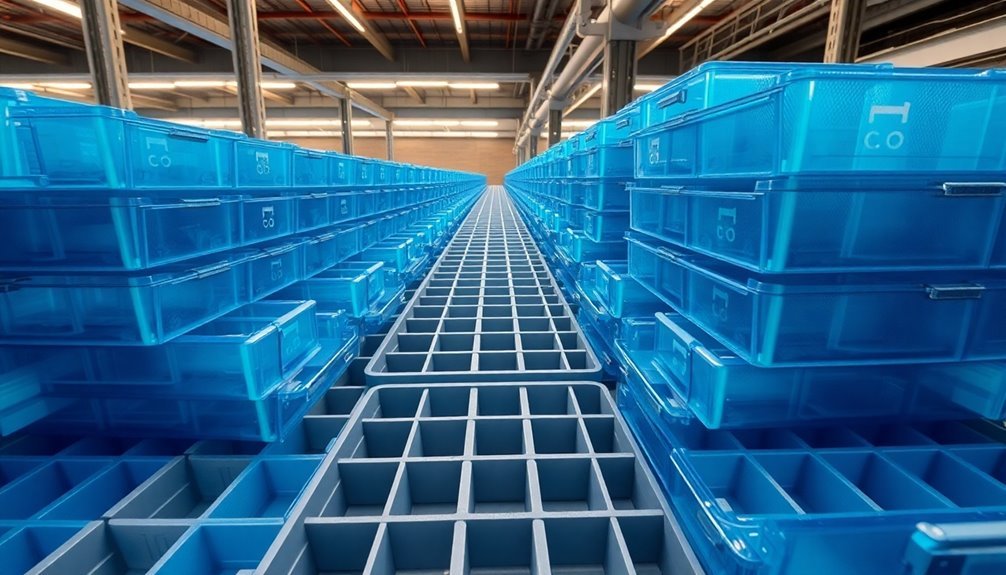ESD-safe storage bins with built-in divider systems offer you essential protection for sensitive electronic components while streamlining your organization process. You'll find these bins feature conductive plastics and carbon-filled materials that neutralize static electricity, meeting ANSI/ESD S20.20 standards. The "no guess" divider grids allow you to create custom compartments on 1.25" centers, with numbered slots for easy divider placement and removal. They're stackable for space efficiency and come with clear labeling options. From varying sizes to multiple configuration options, these storage solutions provide extensive benefits that'll transform your component management approach.
Understanding Built-In Divider Systems

Built-in divider systems revolutionize how you organize and store components in ESD-safe storage bins. These systems feature molded "no guess" divider grids that let you create custom compartments on 1.25" centers, guaranteeing precise organization for your sensitive electronic components.
You'll find numbered slots throughout the bin, making it simple to add or remove dividers as your storage needs change. When you use these divider systems, you'll maximize your storage efficiency while protecting your products. The super strong polypropylene construction ensures exceptional durability. Each container can safely hold up to 40 lbs of materials.
The dividers slide smoothly into place, preventing part migration and keeping your components securely separated. You can adjust the configuration at any time, eliminating wasted space that often occurs with fixed divider locations. For additional protection, you can choose between snap-on or insert-style lids to keep dust and debris away from your stored items.
You'll find these divider systems particularly valuable in warehouse storage, assembly operations, and distribution centers. The bins are stackable, helping you make the most of your vertical space.
For easy identification, you can attach snap-on cardholders, and when you need to move multiple containers, heavy-duty dollies are available to guarantee safe transport.
Components and Material Construction
Three essential components define ESD-safe storage bins: conductive plastics, carbon-filled copolymers, and high-quality polypropylene. You'll find these materials working together to create a reliable static-safe environment for your sensitive electronic components. The conductive plastics and carbon-filled copolymers effectively neutralize and discharge static electricity, while the polypropylene guarantees durability in demanding industrial settings. The bins come in multiple size options to accommodate various storage needs.
When you're selecting ESD-safe storage bins, you'll notice they meet vital industry standards like IEC 61340 and ANSI ESD-S20.20. These standards confirm that the materials provide consistent protection against electrostatic discharge. Many bins include front label holders for easy identification and organization of stored components.
The bins' construction incorporates recyclable materials, aligning with sustainable manufacturing practices while maintaining the highest level of ESD protection.
You can use these bins across various industries, from electronics assembly to automotive manufacturing. They're specifically designed to integrate with standard shelving and workstations, making them ideal for engineering labs and production facilities.
The materials' durability assures they'll withstand daily use in industrial environments, while their static dissipative properties protect your valuable components from potentially damaging electrostatic charges.
Customization Options for Storage Needs

Whether you're managing small components or large circuit boards, ESD-safe storage bins offer extensive customization options to match your specific requirements.
You'll find various configurations, including conductive and dissipative divider tote boxes that feature stacking ridges and ribbed walls for enhanced strength and versatility. Established in 1983, Correct Products leads the industry in providing reliable static control solutions.
You can customize your storage space with adjustable divider grids set on 1.25" centers, creating compartments as small as 1¼" square. The pricing per divider starts at $1.85 for standard quantities. The carbon-infused walls protect your electronics from static damage, while the dividers come in different lengths and quantities to suit specific bin sizes.
For added flexibility, you can opt for short dividers to create varied compartment heights.
You'll also find a range of accessories to enhance your storage solution. Snap-on covers and drop-in lids protect contents from debris, while ESD-safe cardholders help you identify stored items easily.
For larger storage needs, you can choose mobile dollies for convenient transport. If you need custom solutions, you can order specific sizes with unique partition configurations, handles, and ESD foam inserts.
Bulk orders allow for additional customizations beyond standard offerings, including various materials like carbon-filled copolymers.
Selecting Appropriate Bin Sizes
Selecting the right ESD-safe bin size depends on your specific storage and handling requirements. You'll find depths ranging from 2.25" to 10.75", heights from 0.5" to 3", and lengths spanning from 16mm to 28.125".
The Corstat Tote Series from Conductive Containers offers multiple size variations to suit diverse storage needs.
Consider your available space and the dimensions of components you'll store when making your selection.
When choosing bin sizes, you'll want to account for both current and future storage needs. The 21 different sizes offered by STEMO provide flexibility for various electronic components, from tiny resistors to larger circuit boards.
You can opt for stackable designs to maximize vertical space or nesting bins when you need to conserve storage area. The smart container stops ensure bins remain securely in place during stacking operations.
For enhanced organization, look for bins with built-in divider systems that let you create customized compartments.
Width options from 12mm to 20.625" accommodate different component sizes, while various depth choices help optimize shelf space.
Remember that all bins are manufactured from conductive polypropylene to meet IEC 61340 standards for static protection.
If standard sizes don't meet your needs, you can request custom configurations complete with accessories like labels and label holders.
Proper Implementation and Usage Guidelines

Once you've chosen the right bin sizes, proper implementation guarantees their effectiveness in protecting your ESD-sensitive components. To maintain peak performance, you'll need to establish strict handling protocols within your static-controlled environment.
Begin by training your staff on proper ESD bin usage and confirm they understand the importance of minimizing direct contact with sensitive components. Always place your ESD bins on grounded surfaces during transportation and storage.
You'll want to use dividers effectively, positioning them on 1.25" centers to create custom compartments that prevent components from touching each other. When cleaning the bins, use only non-abrasive materials to preserve the static dissipative properties of the carbon-filled copolymer surface.
Keep your ESD bins in dry conditions and regularly inspect them for wear or damage that could compromise their protective qualities. Don't forget to utilize available accessories like snap-on covers and ESD-safe cardholders for proper content identification.
Remember to maintain compliance with ANSI/ESD S20.20 standards by conducting regular static monitoring and keeping detailed usage records. If you're shipping components, secure the bins properly and use only static-safe packaging materials to confirm continued protection throughout transit.
Frequently Asked Questions
What Is the Average Lifespan of Esd-Safe Dividers Under Normal Use Conditions?
You'll find that ESD-safe dividers typically last 2 to 5 years under normal use conditions. However, your maintenance practices, handling frequency, and environmental factors can notably impact how long they'll remain effective.
Can ESD Bins With Dividers Be Safely Cleaned With Standard Cleaning Solutions?
You can safely clean ESD bins with dividers using standard cleaning solutions, but make certain they're residue-free. Just follow manufacturer guidelines, wipe gently with soft cloths, and rinse thoroughly to maintain static control properties.
How Often Should ESD Properties of Divided Storage Bins Be Tested?
You'll need to test your divided storage bins' ESD properties at least annually, but you should increase testing frequency if they're heavily used or exposed to harsh conditions that could affect their static-control capabilities.
Do Temperature Extremes Affect the ESD Protection Capabilities of Divider Systems?
Yes, you'll find that extreme temperatures can compromise your dividers' ESD protection. High heat or cold can alter the conductive properties of the materials, reducing their ability to dissipate static electricity effectively.
Are Replacement Dividers Compatible Across Different Manufacturer Brands of ESD Bins?
You won't find much cross-brand compatibility for replacement dividers. Each manufacturer designs unique specifications, and using dividers from different brands can compromise your ESD protection. It's best to stick with original manufacturer parts.
In Summary
By carefully selecting and implementing ESD-safe storage bins with built-in divider systems, you'll optimize your workspace while protecting sensitive electronic components. You can customize the compartment sizes to match your inventory needs and guarantee proper organization. Remember to regularly assess your storage requirements and adjust the divider configurations accordingly. When you follow proper ESD safety protocols, you're maximizing both efficiency and component protection.





Leave a Reply